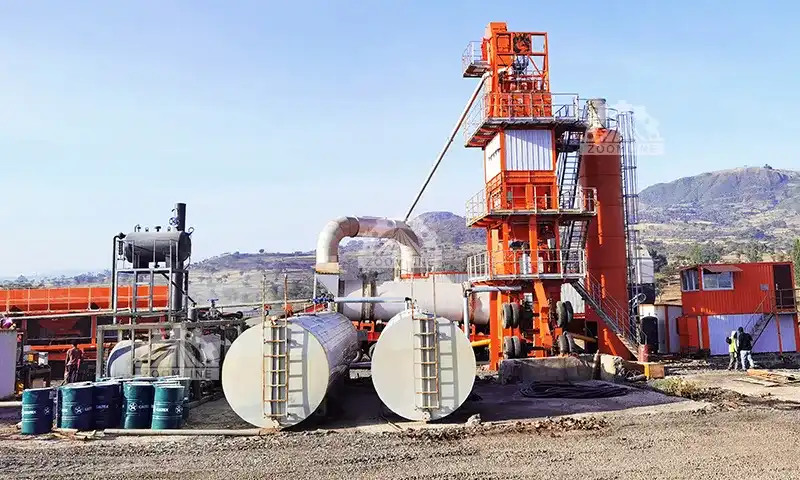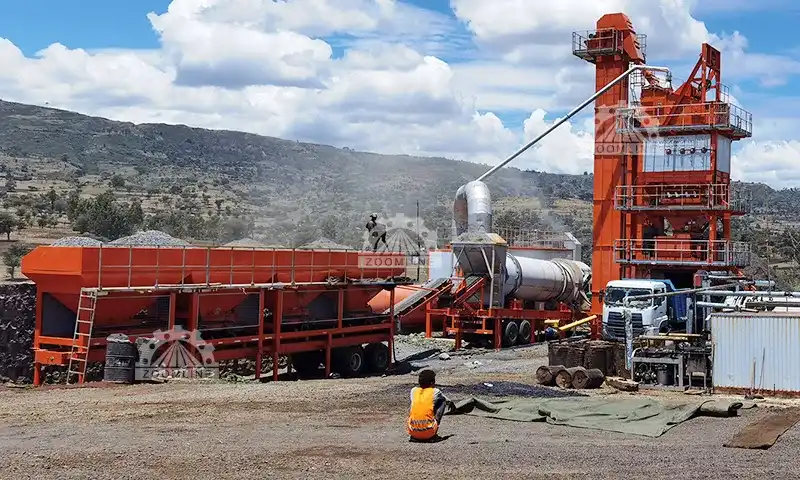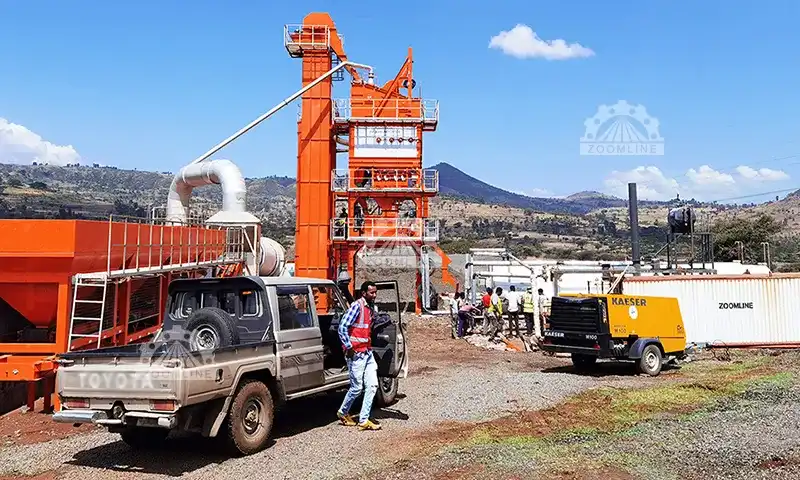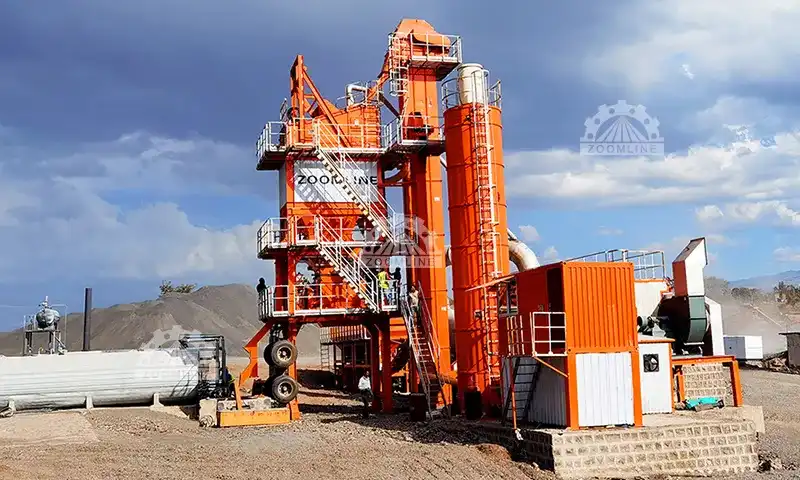In major projects such as highway construction, urban road maintenance, and airport runway paving, asphalt batch mix plants play a pivotal role as “asphalt mixture processing factories.” Through its unique “batch weighing – precise mixing – metered discharge” process, it produces asphalt mixtures meeting stringent quality standards, directly determining pavement strength, durability, and traffic safety. Understanding its core components and standard operating procedures not only enhances production efficiency and ensures mixture quality but also extends equipment lifespan while reducing operational costs. This article systematically dissects the five key components of asphalt batch mixing equipment, explains the full operational logic, and shares optimization techniques and troubleshooting methods to help industry professionals maximize equipment performance.
An asphalt batch mix plant is specialized equipment for producing asphalt mixtures in batches. Its core operational principle follows a closed-loop process: “Graded Material Feeding → Drying and Heating → Precise Weighing → Forced Mixing → Batch Discharge.” Compared to continuous mixers, its key advantages lie in: – High material proportioning accuracy: Strictly controls each raw material’s quantity according to construction formulas. – Flexible batch adjustment: Enables rapid switching between mix designs based on project requirements. This makes it ideal for small-to-medium-scale projects with stringent quality demands and scenarios requiring multiple mix specifications.
From laying asphalt base courses on highways to maintaining and repairing urban access roads, and even producing special-graded mixes for airport runways, asphalt batch mixers have become indispensable core equipment in road construction due to their stable quality control capabilities.

The cold aggregate feeding system serves as the plant’s “raw material inlet,” primarily comprising three components: aggregate bins, conveyor belts, and vibrating feeders. Cold aggregates like sand and gravel of different particle sizes are stored in separate bins. The vibrating feeder conveys aggregates at a steady rate to the conveyor belt according to preset formulas, which then precisely delivers them to the drying drum. The operational stability of this component directly impacts the continuity of raw material supply for subsequent processes. Uneven feeding can cause aggregate gradation imbalance across the entire batch.
The drying and heating system performs the core functions of “moisture removal and temperature elevation,” comprising a drying drum, burner, and hot air ducts. Moist aggregates entering the rotating drum are thoroughly exposed to high-temperature hot air generated by the burner. This process rapidly removes moisture (target moisture content below 0.5%) and heats the aggregates to a preset temperature (typically matching asphalt temperature). Burner flame intensity and hot air temperature require real-time adjustment based on initial aggregate moisture content, while drum rotation speed determines heating duration. This coordinated operation ensures uniform aggregate heating.
Heated aggregates undergo screening and weighing before entering the mixing stage, accomplished by a vibrating screen, hot aggregate bins, and weighing hoppers. The vibrating screen classifies hot aggregates by particle size, with different specifications stored in corresponding hot aggregate bins—achieving “graded storage.” Subsequently, the weighing hoppers precisely measure hot aggregate from each bin according to mix design requirements, with tolerances maintained within extremely narrow ranges. This component is critical for ensuring the mix gradation meets design standards. Any blockage in the vibrating screen or inaccuracy in weighing will directly result in insufficient pavement strength.
The asphalt supply and metering system determines the mixture’s bonding properties, primarily comprising the asphalt storage tank, asphalt pump, and metering cylinder. The asphalt storage tank must possess heating and insulation capabilities to maintain asphalt at a flowing state between 150-170°C. The asphalt pump conveys asphalt to the metering system, which precisely measures the asphalt quantity according to the mix design before feeding it into the mixing drum. Even a 0.5% deviation in asphalt content can cause pavement cracking and loosening, making the metering accuracy of this system directly critical to pavement durability.
The mixing system serves as the core component for blending all raw materials into a uniform mixture, primarily consisting of a twin-shaft forced-action mixing drum and discharge gate. Precisely weighed hot aggregates, asphalt, and mineral powder enter the mixing drum together. Dual-shaft blades rotate at high speed to forcefully mix the materials, forming a uniformly blended asphalt mixture within 30-60 seconds. This dual-shaft forced mixing method effectively prevents issues like “clumping” and “segregation.” The timing of the discharge gate’s opening and closing must precisely coordinate with subsequent storage or transportation processes.

Equipment Inspection: Conduct a comprehensive check of critical components such as the vibrating feeder, burner, and mixing drum. Focus on verifying the responsiveness of safety devices (e.g., emergency stop buttons, temperature alarms) and inspecting conveyor belts and seals for damage.
Material Preparation: Verify cold aggregate is stored in graded piles, asphalt is heated to the optimal temperature of 150-170°C, and mineral powder reserves are sufficient and free of clumping.
Parameter Setup: Input the mix design into the control system, specifying key parameters such as aggregate gradation ratios, asphalt content, and mixing duration. Complete a no-load trial run of the equipment.
Cold Aggregate Conveying: Upon system startup, the vibrating feeder operates precisely according to preset ratio parameters, uniformly feeding cold aggregates like limestone and basalt onto the variable-speed conveyor belt. Constructed from wear-resistant rubber and equipped with anti-drift devices, the belt transports aggregates at a constant speed to the drying drum inlet, ensuring continuous and stable feed supply.
Drying and Heating: The burner employs dual-fuel oil/gas combustion technology, generating a high-speed rotating hot air vortex upon ignition. The 3-4 meter diameter drying drum rotates continuously at 3-5 revolutions per minute. Internal spiral blades constantly tumble the aggregate, ensuring thorough contact with the hot air. An intelligent temperature control system monitors in real time, heating the aggregate to the target temperature of 160-180°C while effectively removing over 98% of surface moisture.
Hot Aggregate Screening and Storage: The dried hot aggregate enters a four-layer vibrating screen for precise grading. The screens are constructed from high-strength stainless steel and operate at a vibration frequency of 800-1000 times per minute. Graded aggregates (0-3mm, 3-5mm, 5-10mm, 10-15mm) are directed through pneumatic valves to precisely fall into their corresponding hot aggregate silos. Each silo is equipped with a level sensor for real-time inventory monitoring and feedback to the control system.
Precise Raw Material Weighing: Hot aggregate utilizes a dynamic weighing hopper with an integrated high-precision load cell (accuracy ±0.5%), paired with a variable-frequency feeder for rapid coarse weighing and micro-precision fine weighing. The asphalt weighing tank features an anti-adhesion coating design, with precise metering achieved via a servo motor-controlled asphalt pump. Mineral powder is metered using screw conveyors paired with loss-in-weight scales. All three materials undergo coordinated metering via the PLC control system, ensuring mix ratio deviations are maintained within ±1%.
Forced Mixing: Three raw materials are simultaneously fed into the twin-shaft forced-action mixing drum via pneumatic butterfly valves. Inside the drum, 42 high-chromium alloy mixing blades arranged in an interlaced pattern rotate at high speed at 80-100 rpm. During mixing, asphalt uniformly coats aggregate surfaces while mineral powder fills voids. After 30-60 seconds of high-intensity mixing, a well-graded mixture with precise oil-to-aggregate ratio is formed.
Finished Product Discharge: Upon mixing completion, the discharge door rapidly opens via hydraulic drive. The finished mixture flows through an inclined discharge chute into the storage silo. The storage bin features insulation and level monitoring devices, or the mix may be directly discharged into transport trucks. Upon completion of discharge, the system automatically initiates the next production cycle, achieving fully automated control throughout the process.
Thorough Cleaning: Immediately after each production run, perform deep cleaning of critical components including the mixing drum, weighing hoppers, and discharge ports. Use specialized tools to scrape hardened mixture adhering to the drum interior. Employ high-pressure air to blow out sensors and internal dead corners of the weighing hopper, preventing residual material from solidifying and clumping upon cooling, which could cause equipment jamming or measurement inaccuracies. For highly adhesive asphalt mixtures, use specialized cleaning agents to ensure no material residue remains inside the equipment.
Equipment Maintenance:
Lubrication Maintenance: Regularly apply high-temperature resistant, wear-resistant lubricants to moving components such as conveyor belt idlers, mixing blade bearings, and elevator chains according to the equipment manual. Ensure 100% lubrication coverage to extend mechanical component lifespan.
Burner Inspection: Weekly check burner nozzle atomization. Use specialized cleaning needles to clear blocked orifices. Simultaneously inspect gas/fuel line seals to prevent equipment failures caused by incomplete combustion.
Screening System Maintenance: After daily shutdown, remove the vibrating screen mesh to clear fine aggregates and debris embedded in the screen holes. Inspect the screen mesh for wear and promptly replace damaged screens to ensure screening efficiency and finished material quality.
Safety Measures:
Energy Isolation: After shutdown, strictly execute the “Three Cutoffs” procedure: disconnect the main power supply, close fuel supply valves, and halt the asphalt heating system. Ensure all energy inputs are terminated and post a “DO NOT OPERATE” warning sign on the distribution panel.
Data Recording: Detailed records must be maintained for daily production batches, mix proportions, output volumes, and equipment operating parameters. Abnormal operating conditions and corrective actions should be specifically documented. Additionally, equipment operation logs must be accurately completed, including maintenance activities, fault occurrence times, and solutions. This provides comprehensive documentation for subsequent production management and equipment maintenance.

Vibrating Screen: As the core for precise aggregate grading, establish a regular inspection mechanism. Weekly checks should assess screen mesh wear, focusing on edges and stress points. Immediately shut down and replace the screen if holes exceeding 5mm appear to prevent gradation imbalance. During screen replacement, simultaneously inspect tension to ensure even stress distribution.
Drying Drum: Prone to damage from prolonged high temperatures and aggregate abrasion. Pre-treat new equipment with 0.3-0.5mm thick high-temperature resistant ceramic or tungsten carbide coating before commissioning. Quarterly inspections during operation should check for coating peeling, promptly reapplying to worn areas. Use a distributor to evenly spread material, reducing localized wear.
Asphalt Storage Tank: Insulated with double-layer polyurethane foam and aluminum foil reflective layer, maintaining a tank-to-ambient temperature differential ≤10°C. Monitor asphalt temperature daily. Clean tank bottom impurities monthly with protective measures during cleaning. Inspect seals post-cleaning to prevent asphalt aging.
Adjust burner flame intensity based on aggregate initial moisture content. Increase flame when moisture is high to prevent substandard heating; Under conditions ensuring mix homogeneity, appropriately shorten mixing time (minimum 30 seconds) to enhance batch production efficiency; Optimize material conveyance routes to reduce conveyor belt idle time and lower energy consumption.
Recover waste heat from the drying drum to preheat cold aggregate or heat asphalt, reducing fuel consumption; Use variable frequency motors to control conveyor belt and mixing drum speeds, adjusting power output based on production load; Rationally plan raw material storage locations to minimize material transfer distances and reduce transportation energy consumption.
Vibrating screen clogging: Often caused by excessively high moisture content in hot aggregate or improper screen mesh selection. Shut down the machine to clean the screen and adjust the drying drum heating temperature.
Uneven Aggregate Feeding: May result from insufficient vibrating feeder amplitude or blockage at the aggregate bin outlet. Inspect feeder parameters and clear debris from the outlet.
Burner Flame Extinction: Commonly caused by insufficient fuel supply or carbon buildup on the ignition electrode. Inspect fuel lines and clean the ignition electrode.
Fluctuating mix temperature: Typically caused by unstable burner flame or abnormal dryer drum speed. Adjust burner fuel/gas supply pressure and calibrate drum speed.
Inaccurate weighing: May result from weighing hopper sensor failure or material adhesion. Inspect sensors and remove residual material from the weighing hopper.
Mixing drum jamming: Typically caused by solidified mixture blockage or blade wear/deformation. Shut down the machine to clear obstructions and replace worn blades.

Future equipment will extensively incorporate automated control systems, using AI algorithms to automatically adjust raw material ratios and heating temperatures. Concurrently, IoT technology will enable real-time monitoring of component status, providing early warnings of potential failures to minimize downtime.
Low-emission burners will become standard equipment, significantly reducing nitrogen oxide and particulate matter emissions. Furthermore, specialized components for processing waste asphalt mixtures will gradually become widespread, enabling resource recycling.
High-speed mixing drums will further enhance mixing efficiency, shortening batch production times; while new energy-saving drying systems optimize hot air circulation to reduce fuel consumption by 15%-20%, achieving a balance between high efficiency and energy conservation.
The stable operation of intermittent asphalt mixing plants relies on the coordinated functioning of five core asphalt plant components: cold aggregate feeding, drying and heating, hot aggregate screening and weighing, asphalt supply and weighing, and mixing. It further depends on standardized processes encompassing “pre-production preparation, batch production, and post-production maintenance.” Only through regular component maintenance and operational process control can high-quality asphalt mix be consistently produced, ensuring the quality of road construction projects.